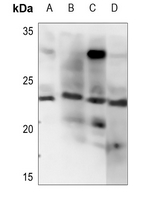Anti-Endothelin 1 Antibody
Rabbit polyclonal antibody to Endothelin 1
- SPECIFICATION
- CITATIONS
- PROTOCOLS
- BACKGROUND

Application
| WB |
|---|---|
| Primary Accession | P05305 |
| Other Accession | P22387 |
| Reactivity | Human, Rat |
| Host | Rabbit |
| Clonality | Polyclonal |
| Calculated MW | 24425 Da |
| Gene ID | 1906 |
|---|---|
| Other Names | Endothelin-1; Preproendothelin-1; PPET1 |
| Target/Specificity | KLH-conjugated synthetic peptide encompassing a sequence within the center region of human Endothelin 1. The exact sequence is proprietary. |
| Dilution | WB~~WB (1/500 - 1/1000) |
| Format | Liquid in 0.42% Potassium phosphate, 0.87% Sodium chloride, pH 7.3, 30% glycerol, and 0.09% (W/V) sodium azide. |
| Storage | Store at -20 °C.Stable for 12 months from date of receipt |
| Name | EDN1 |
|---|---|
| Function | Endothelins are endothelium-derived vasoconstrictor peptides (By similarity). Probable ligand for G-protein coupled receptors EDNRA and EDNRB which activates PTK2B, BCAR1, BCAR3 and, GTPases RAP1 and RHOA cascade in glomerular mesangial cells (PubMed:19086031). Also binds the DEAR/FBXW7-AS1 receptor (PubMed:17446437). Promotes mesenteric arterial wall remodeling via activation of ROCK signaling and subsequent colocalization of NFATC3 with F-actin filaments (By similarity). NFATC3 then translocates to the nucleus where it subsequently promotes the transcription of the smooth muscle hypertrophy and differentiation marker ACTA2 (By similarity). |
| Cellular Location | Secreted. |
| Tissue Location | Expressed in lung, placental stem villi vessels and in cultured placental vascular smooth muscle cells |

Thousands of laboratories across the world have published research that depended on the performance of antibodies from Abcepta to advance their research. Check out links to articles that cite our products in major peer-reviewed journals, organized by research category.
info@abcepta.com, and receive a free "I Love Antibodies" mug.
Provided below are standard protocols that you may find useful for product applications.
Background
KLH-conjugated synthetic peptide encompassing a sequence within the center region of human Endothelin 1. The exact sequence is proprietary.
If you have used an Abcepta product and would like to share how it has performed, please click on the "Submit Review" button and provide the requested information. Our staff will examine and post your review and contact you if needed.
If you have any additional inquiries please email technical services at tech@abcepta.com.













 Foundational characteristics of cancer include proliferation, angiogenesis, migration, evasion of apoptosis, and cellular immortality. Find key markers for these cellular processes and antibodies to detect them.
Foundational characteristics of cancer include proliferation, angiogenesis, migration, evasion of apoptosis, and cellular immortality. Find key markers for these cellular processes and antibodies to detect them. The SUMOplot™ Analysis Program predicts and scores sumoylation sites in your protein. SUMOylation is a post-translational modification involved in various cellular processes, such as nuclear-cytosolic transport, transcriptional regulation, apoptosis, protein stability, response to stress, and progression through the cell cycle.
The SUMOplot™ Analysis Program predicts and scores sumoylation sites in your protein. SUMOylation is a post-translational modification involved in various cellular processes, such as nuclear-cytosolic transport, transcriptional regulation, apoptosis, protein stability, response to stress, and progression through the cell cycle. The Autophagy Receptor Motif Plotter predicts and scores autophagy receptor binding sites in your protein. Identifying proteins connected to this pathway is critical to understanding the role of autophagy in physiological as well as pathological processes such as development, differentiation, neurodegenerative diseases, stress, infection, and cancer.
The Autophagy Receptor Motif Plotter predicts and scores autophagy receptor binding sites in your protein. Identifying proteins connected to this pathway is critical to understanding the role of autophagy in physiological as well as pathological processes such as development, differentiation, neurodegenerative diseases, stress, infection, and cancer.


